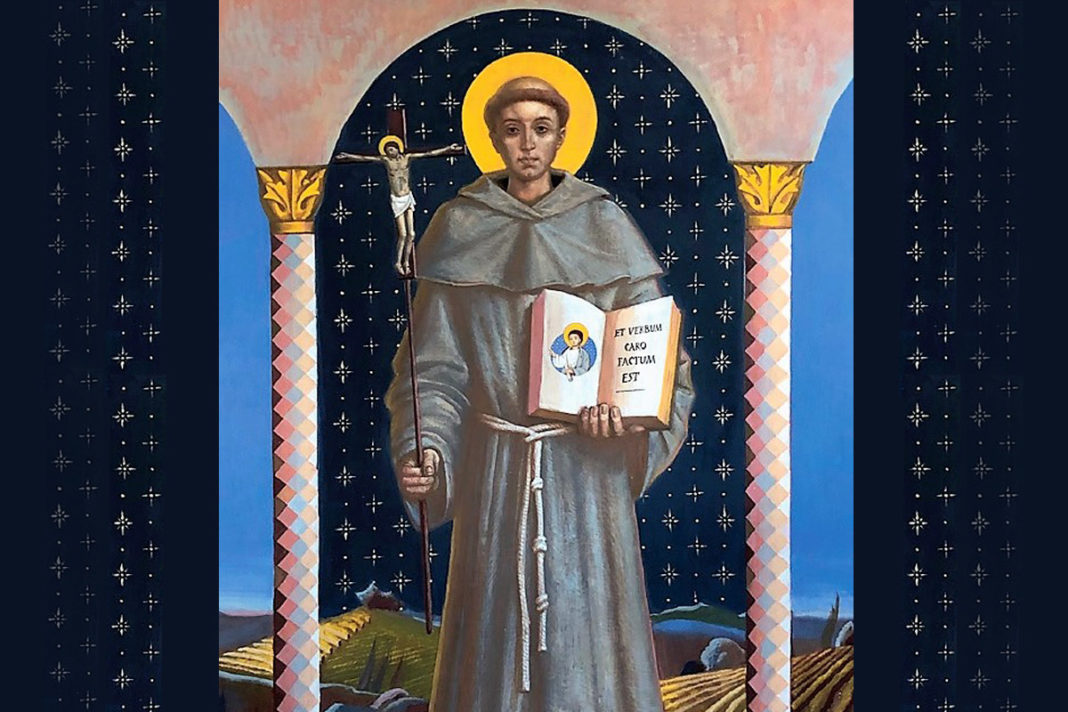On November 1, 2020, the Solemnity of All Saints, the Vicar General, Friar Jan MACIEJOWSKI, presided over an unveiling and blessing ceremony for a portrait of St. Anthony of Padua. It was painted by the well-known Bulgarian artist, Atanas ATANASSOV. The ceremony took place at the Friary of St. Anthony at the Baths in Rome.
St. Anthony is the patron saint of the friary. The artist painted his image on a wooden panel. He depicts St. Anthony wearing sandals and the traditional ash-colored habit of the early friars. The saint is also identified with writing below his feet. In keeping with the custom of sacred art, the figure of the saint occupies the central field of the painting for almost its entire height. The scenic background is comprised of a triple arch, which can be understood as a reference to the Chapel of the Ark at the Basilica of St. Anthony in Padua or simply as the arches of a cloister. Beyond it, the countryside opens up to show a pleasant, silent and solitary landscape, far away from the din of the city. It evokes the years the saint spent in a hermitage.
The saint is depicted facing front. His image is less rigid and hieratic than works that follow the canons of byzantine painting and is more in keeping with his earlier representations. The figure stands out against a dark background, studded with repeated, bright, four-pointed stars. His head is surrounded by a full halo, a distinctive element of the saints.
The personality of the saint is distinguished by two symbols he holds in his hands: a Crucifix on the right and a book of the Gospels on the left. This is different from his traditional iconographic symbology which usually shows him holding the Child Jesus and an Easter lily. In this painting, the Child Jesus has been replaced by the Crucifix. This break with the traditional canons is likely aimed at transmitting a clear theological and specifically Christological message to the viewer, in accordance with the essence of the saint’s tireless preaching.
As a modern work, the painting is beautiful and refined and shows excellent artistic taste. Its bright colors are well harmonized with each other. The painting has a fully classical perspective, showing rolling hills covered with wheat fields and vineyards; these are easily identifiable with external spaces of the Vigna Friary in Rome.
In conclusion, any visitor seeing this painting adorning the entrance of the friary will find himself involved in the scene and pervaded by a sense of familiar welcome.
During the celebration, the friars of the community renewed their desire to be continually inspired by St. Anthony. He is an undisputed example of generous self-giving and commitment to fraternity. In this regard, the friars decided to insert various spiritual reflections related to the saint into their Spiritual House Chapters for the 2020-21 year. These reflections will start as early as this month and the topics chosen for them will be Advent, preaching, justice and peace and Marian devotion—always from the perspective of the spirituality of St. Anthony.
Friar Simone SCHIAVONE












![Interview Regarding Pope Sixtus V [Felice Peretti] (1585-1590) Fra Domenico (Mimmo) CASTIGLIONE](https://www.ofmconv.net/wp-content/uploads/2024/04/d-06-02-24-02-150x150.jpg)



